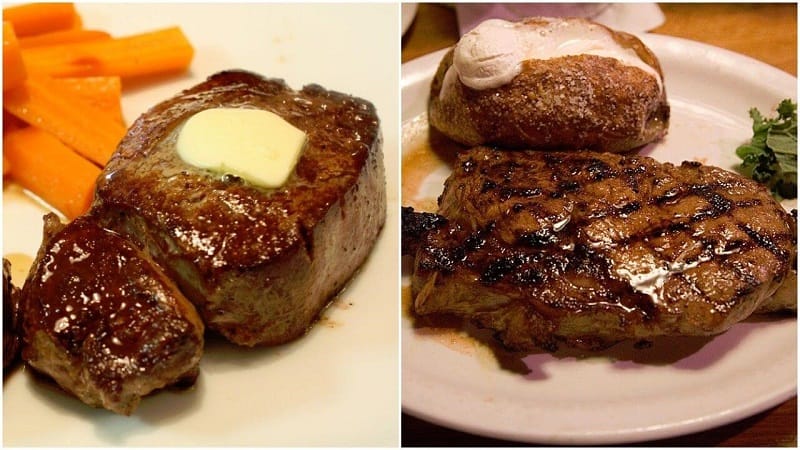When considering premium cuts of steak, Filet Mignon and Ribeye are undoubtedly at the top of the list for steak enthusiasts. Both cuts are celebrated for their rich flavors and tender textures, making them a staple in fine dining restaurants worldwide.
However, despite their popularity, these two steaks have distinct differences that can influence your choice depending on preference, cooking method, and occasion.
Understanding the Cuts
Revered as the most tender cut of beef, Filet Mignon is sourced from the smaller end of the tenderloin, situated along the spine in the loin section. This muscle does very little work, resulting in its notable tenderness. It is characterized by its mild flavor and lean profile, with minimal fat marbling. It’s often served in smaller, thick cuts that are best cooked using methods that can introduce additional flavors.
On the flip side, the Ribeye comes from the rib section of the beef, specifically from ribs six through twelve, and is known for its substantial marbling and richer flavor. This cut includes a mix of muscle and fat, including the ‘eye’ of meat and the cap, contributing to its juiciness and taste. Ribeye steaks can be cut bone-in or boneless, typically larger and thicker than Filet Mignon.
Taste and Texture
Source: https://www.mychicagosteak.com/
Filet Mignon: This cut is celebrated for its buttery texture that almost melts in the mouth. Its subtle beefy flavor makes it a perfect canvas for various seasonings and sauces, from simple salt and pepper to more complex wine reductions. Due to its low-fat content, it can become dry if overcooked, so most chefs recommend cooking it no more than medium-rare to medium.
Ribeye: The hallmark of a Ribeye is its robust beef flavor, attributed to the high degree of fat marbling within the meat. This fat renders down during cooking, infusing the steak with flavor and maintaining its moisture, resulting in a juicy, rich steak. Its texture is slightly chewier than Filet Mignon but still tender, especially when eaten medium-rare to medium.
Cooking Techniques
Given its lean nature, Filet Mignon is best cooked quickly over high heat. Methods like grilling, broiling, or pan-searing are ideal for developing a flavorful crust while keeping the inside tender and juicy. Wrapping the filet in bacon or serving it with a buttery sauce can add the needed fat for extra flavor.
Ribeye steaks are versatile and can be cooked using various methods, including grilling, pan-searing, and broiling. The key is to cook them on medium heat to allow the fat to render evenly, enhancing the meat’s flavor without causing flare-ups on the grill or excessive smoking in the pan. Given its rich flavor, a Ribeye often needs little more than salt and pepper to shine.
Price Point and Serving Suggestions
Generally, Filet Mignon is more expensive per pound than Ribeye due to its tenderness and the limited amount available on each cow. It is often served in smaller portions, making it a special-occasion steak, ideal for refined dishes accompanied by elegant sides such as roasted vegetables, mashed potatoes, or risotto.
Ribeye offers more bang for your buck, providing a larger, more flavorful steak at a lower price than Filet Mignon. Its hearty flavor makes it perfect for casual meals, needing little more than a simple side salad or baked potato to round out a fulfilling dinner.
Conclusion
Choosing between both ultimately comes down to personal preference in texture and flavor. Whether you prefer the buttery tenderness of a Filet Mignon or the rich, beefy taste of a Ribeye, both cuts offer a luxurious steak experience that, when appropriately cooked, can be the highlight of any meal.

Welcome to the captivating world of Tusks Bar and Grill, an East African Fusion restaurant nestled in the heart of Calgary, Canada. Tusks Bar and Grill is a culinary gem that brings together the vibrant flavors and rich culinary traditions of East Africa, creating a truly unique and unforgettable dining experience.
